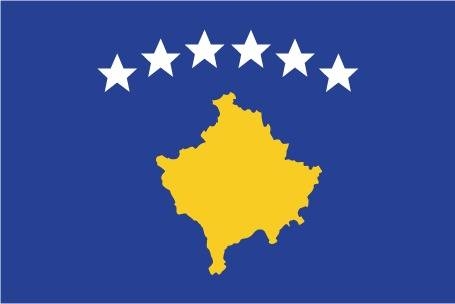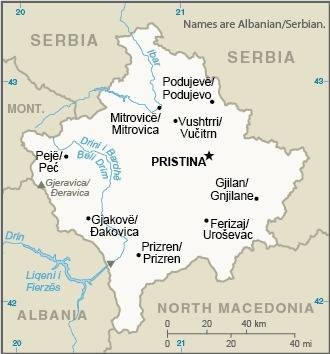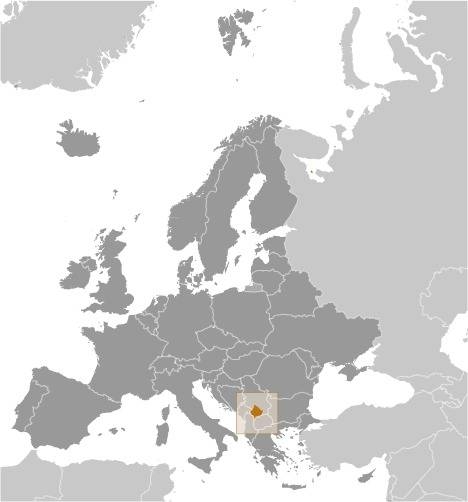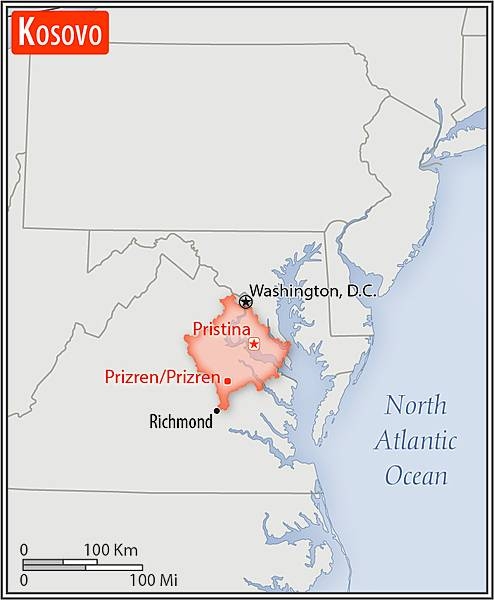Introduction
Background
The central Balkans were part of the Roman and Byzantine Empires before ethnic Serbs migrated to the territories of modern Kosovo in the 7th century. During the medieval period, Kosovo became the center of a Serbian Empire and saw the construction of many important Serb religious sites, including many architecturally significant Serbian Orthodox monasteries. The defeat of Serbian forces at the Battle of Kosovo in 1389 led to five centuries of Ottoman rule during which large numbers of Turks and Albanians moved to Kosovo. By the end of the 19th century, Albanians replaced Serbs as the dominant ethnic group in Kosovo. Serbia reacquired control over the region from the Ottoman Empire during the First Balkan War of 1912. After World War II, Kosovo's present-day boundaries were established when Kosovo became an autonomous province of Serbia in the Socialist Federal Republic of Yugoslavia (S.F.R.Y.). Despite legislative concessions, Albanian nationalism increased in the 1980s, which led to riots and calls for Kosovo's independence. The Serbs - many of whom viewed Kosovo as their cultural heartland - instituted a new constitution in 1989 revoking Kosovo's autonomous status. Kosovo's Albanian leaders responded in 1991 by organizing a referendum declaring Kosovo independent. Serbia undertook repressive measures against the Kosovar Albanians in the 1990s, provoking a Kosovar Albanian insurgency.
Beginning in 1998, Serbia conducted a brutal counterinsurgency campaign that resulted in massacres and massive expulsions of ethnic Albanians (some 800,000 ethnic Albanians were forced from their homes in Kosovo). After international attempts to mediate the conflict failed, a three-month NATO military operation against Serbia beginning in March 1999 forced the Serbs to agree to withdraw their military and police forces from Kosovo. UN Security Council Resolution 1244 (1999) placed Kosovo under a transitional administration, the UN Interim Administration Mission in Kosovo, pending a determination of Kosovo's future status. A UN-led process began in late 2005 to determine Kosovo's final status. The 2006-07 negotiations ended without agreement between Belgrade and Pristina, though the UN issued a comprehensive report on Kosovo's final status that endorsed independence. On 17 February 2008, the Kosovo Assembly declared Kosovo independent. Since then, close to 100 countries have recognized Kosovo, and it has joined numerous international organizations. In October 2008, Serbia sought an advisory opinion from the International Court of Justice (ICJ) on the legality under international law of Kosovo's declaration of independence. The ICJ released the advisory opinion in July 2010 affirming that Kosovo's declaration of independence did not violate general principles of international law, UN Security Council Resolution 1244, or the Constitutive Framework. The opinion was closely tailored to Kosovo's unique history and circumstances.
Demonstrating Kosovo’s development into a sovereign, multi-ethnic, democratic country, the international community ended the period of Supervised Independence in 2012. Kosovo held its most recent national and municipal elections in 2021, ushering in a government led by the Self-Determination Movement's (VV) Albin KURTI, a former political prisoner who did not fight in the 1998-99 war. Serbia continues to reject Kosovo's independence, but the two countries agreed in April 2013 to normalize their relations through EU-facilitated talks, which produced several subsequent agreements the parties are implementing to varying degrees, though they have not yet reached a comprehensive normalization of relations. Kosovo has pursued bilateral recognitions and memberships in international organizations, moves that Serbia strongly opposes. Kosovo signed a Stabilization and Association Agreement with the EU in 2015, and the EU named Kosovo as among the six Western Balkan countries that will be able to join the organization once it meets the criteria to accede. Kosovo also seeks memberships in the UN and in NATO.
Visit the Definitions and Notes page to view a description of each topic.
Geography
Location
Southeastern Europe, between Serbia and Macedonia
Geographic coordinates
42 35 N, 21 00 E
Map references
Europe
Land boundaries
total: 714 km
border countries (4): Albania 112 km; North Macedonia 160 km; Montenegro 76 km; Serbia 366 km
Coastline
0 km (landlocked)
Maritime claims
none (landlocked)
Climate
influenced by continental air masses resulting in relatively cold winters with heavy snowfall and hot, dry summers and autumns; Mediterranean and alpine influences create regional variation; maximum rainfall between October and December
Terrain
flat fluvial basin at an elevation of 400-700 m above sea level surrounded by several high mountain ranges with elevations of 2,000 to 2,500 m
Elevation
highest point: Gjeravica/Deravica 2,656 m
lowest point: Drini i Bardhe/Beli Drim (located on the border with Albania) 297 m
mean elevation: 450 m
Natural resources
nickel, lead, zinc, magnesium, lignite, kaolin, chrome, bauxite
Land use
agricultural land: 52.8% (2018 est.)
arable land: 27.4% (2018 est.)
permanent crops: 1.9% (2018 est.)
permanent pasture: 23.5% (2018 est.)
forest: 41.7% (2018 est.)
other: 5.5% (2018 est.)
Major watersheds (area sq km)
Atlantic Ocean drainage: (Black Sea) Danube (795,656 sq km)
Population distribution
population clusters exist throughout the country, the largest being in the east in and around the capital of Pristina
Geography - note
the 41-km long Nerodimka River divides into two branches each of which flows into a different sea: the northern branch flows into the Sitnica River, which via the Ibar, Morava, and Danube Rivers ultimately flows into the Black Sea; the southern branch flows via the Lepenac and Vardar Rivers into the Aegean Sea
People and Society
Nationality
noun: Kosovan
adjective: Kosovan
note: Kosovo, a neutral term, is sometimes also used as a noun or adjective as in Kosovo Albanian, Kosovo Serb, Kosovo minority, or Kosovo citizen
Ethnic groups
Albanians 92.9%, Bosniaks 1.6%, Serbs 1.5%, Turk 1.1%, Ashkali 0.9%, Egyptian 0.7%, Gorani 0.6%, Romani 0.5%, other/unspecified 0.2% (2011 est.)
note: these estimates may under-represent Serb, Romani, and some other ethnic minorities because they are based on the 2011 Kosovo national census, which excluded northern Kosovo (a largely Serb-inhabited region) and was partially boycotted by Serb and Romani communities in southern Kosovo
Languages
Albanian (official) 94.5%, Bosnian 1.7%, Serbian (official) 1.6%, Turkish 1.1%, other 0.9% (includes Romani), unspecified 0.1%; note - in municipalities where a community's mother tongue is not one of Kosovo's official languages, the language of that community may be given official status according to the 2006 Law on the Use of Languages (2011 est.)
major-language sample(s):
Libri i Fakteve Boterore, burimi vital per informacione elementare. (Albanian)
The World Factbook, the indispensable source for basic information.
Religions
Muslim 95.6%, Roman Catholic 2.2%, Orthodox 1.5%, other 0.1%, none 0.1%, unspecified 0.6% (2011 est.)
Age structure
0-14 years: 24.07% (male 241,563/female 223,568)
15-24 years: 16.95% (male 170,566/female 157,063)
25-54 years: 42.56% (male 433,914/female 388,595)
55-64 years: 8.67% (male 85,840/female 81,782)
65 years and over: 7.75% (male 63,943/female 85,940) (2020 est.)
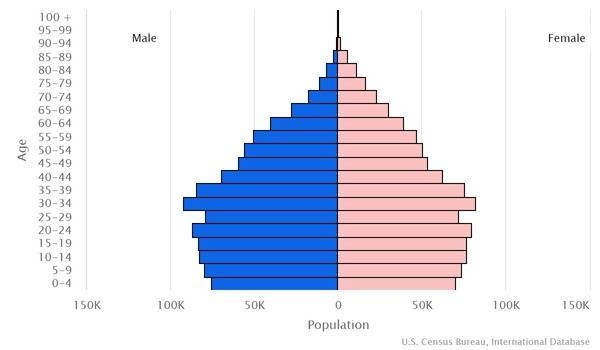
Dependency ratios
total dependency ratio: 46.9
youth dependency ratio: 32.3
elderly dependency ratio: 14.6
potential support ratio: 6.9 (2021)
Median age
total: 30.5 years
male: 30.2 years
female: 30.8 years (2020 est.)
Population distribution
population clusters exist throughout the country, the largest being in the east in and around the capital of Pristina
Major urban areas - population
218,782 PRISTINA (capital) (2020)
Sex ratio
at birth: 1.08 male(s)/female
0-14 years: 1.08 male(s)/female
15-24 years: 1.08 male(s)/female
25-54 years: 1.11 male(s)/female
55-64 years: 1.05 male(s)/female
65 years and over: 0.6 male(s)/female
total population: 1.06 male(s)/female (2022 est.)
Infant mortality rate
total: 27.12 deaths/1,000 live births
male: 28.74 deaths/1,000 live births
female: 25.38 deaths/1,000 live births (2022 est.)
Life expectancy at birth
total population: 71.12 years
male: 68.83 years
female: 73.58 years (2022 est.)
Drinking water source
improved: urban: NA
rural: NA
total: NA
unimproved: urban: NA
rural: NA
total: NA
Sanitation facility access
improved: urban: NA
rural: NA
total: NA
unimproved: urban: NA
rural: NA
total: NA
Youth unemployment rate (ages 15-24)
total: 48.8%
male: 44.9%
female: 57.3% (2020 est.)
Environment
Environment - current issues
air pollution (pollution from power plants and nearby lignite mines take a toll on people's health); water scarcity and pollution; land degradation
Air pollutants
carbon dioxide emissions: 8.94 megatons (2016 est.)
methane emissions: 0.54 megatons (2020 est.)
Climate
influenced by continental air masses resulting in relatively cold winters with heavy snowfall and hot, dry summers and autumns; Mediterranean and alpine influences create regional variation; maximum rainfall between October and December
Land use
agricultural land: 52.8% (2018 est.)
arable land: 27.4% (2018 est.)
permanent crops: 1.9% (2018 est.)
permanent pasture: 23.5% (2018 est.)
forest: 41.7% (2018 est.)
other: 5.5% (2018 est.)
Revenue from forest resources
forest revenues: 0% of GDP (2018 est.)
country comparison to the world: 178Waste and recycling
municipal solid waste generated annually: 319,000 tons (2015 est.)
Major watersheds (area sq km)
Atlantic Ocean drainage: (Black Sea) Danube (795,656 sq km)
Government
Country name
conventional long form: Republic of Kosovo
conventional short form: Kosovo
local long form: Republika e Kosoves (Albanian)/ Republika Kosovo (Serbian)
local short form: Kosove (Albanian)/ Kosovo (Serbian)
etymology: name derives from the Serbian "kos" meaning "blackbird," an ellipsis (linguistic omission) for "kosove polje" or "field of the blackbirds"
Government type
parliamentary republic
Capital
name: Pristina (Prishtine, Prishtina)
geographic coordinates: 42 40 N, 21 10 E
time difference: UTC+1 (6 hours ahead of Washington, DC, during Standard Time)
daylight saving time: +1hr, begins last Sunday in March; ends last Sunday in October
etymology: the name may derive from a Proto-Slavic word reconstructed as "pryshchina," meaning "spring (of water)"
Administrative divisions
38 municipalities (komunat, singular - komuna (Albanian); opstine, singular - opstina (Serbian)); Decan (Decani), Dragash (Dragas), Ferizaj (Urosevac), Fushe Kosove (Kosovo Polje), Gjakove (Dakovica), Gjilan (Gnjilane), Gllogovc (Glogovac), Gracanice (Gracanica), Hani i Elezit (Deneral Jankovic), Istog (Istok), Junik, Kacanik, Kamenice (Kamenica), Kline (Klina), Kllokot (Klokot), Leposaviq (Leposavic), Lipjan (Lipljan), Malisheve (Malisevo), Mamushe (Mamusa), Mitrovice e Jugut (Juzna Mitrovica) [South Mitrovica], Mitrovice e Veriut (Severna Mitrovica) [North Mitrovica], Novoberde (Novo Brdo), Obiliq (Obilic), Partesh (Partes), Peje (Pec), Podujeve (Podujevo), Prishtine (Pristina), Prizren, Rahovec (Orahovac), Ranillug (Ranilug), Shterpce (Strpce), Shtime (Stimlje), Skenderaj (Srbica), Suhareke (Suva Reka), Viti (Vitina), Vushtrri (Vucitrn), Zubin Potok, Zvecan
Independence
17 February 2008 (from Serbia)
National holiday
Independence Day, 17 February (2008)
Constitution
history: previous 1974, 1990; latest (postindependence) draft finalized 2 April 2008, signed 7 April 2008, ratified 9 April 2008, entered into force 15 June 2008; note - amendment 24, passed by the Assembly in August 2015, established the Kosovo Relocated Specialist Institution, referred to as the Kosovo Specialist Chamber or "Specialist Court," to try war crimes allegedly committed by members of the Kosovo Liberation Army in the late 1990s
amendments: proposed by the government, by the president of the republic, or by one fourth of Assembly deputies; passage requires two-thirds majority vote of the Assembly, including two-thirds majority vote of deputies representing non-majority communities, followed by a favorable Constitutional Court assessment; amended several times, last in 2020
Legal system
civil law system; note - the European Union Rule of Law Mission (EULEX) retained limited executive powers within the Kosovo judiciary for complex cases from 2008 to 2018
International law organization participation
has not submitted an ICJ jurisdiction declaration; non-party state to the ICCt
Citizenship
citizenship by birth: no
citizenship by descent only: at least one parent must be a citizen of Kosovo
dual citizenship recognized: yes
residency requirement for naturalization: 5 years
Suffrage
18 years of age; universal
Executive branch
chief of state: President Vjosa OSMANI-Sadriu (since 4 April 2021)
head of government: Prime Minister Albin KURTI (since 22 March 2021)
cabinet: Cabinet elected by the Assembly
elections/appointments: president indirectly elected by at least two-thirds majority vote of the Assembly for a 5-year term; if a candidate does not attain a two-thirds threshold in the first two ballots, the candidate winning a simple majority vote in the third ballot is elected (eligible for a second term); election last held on 3-4 April 2021 (next to be held in 2026); prime minister indirectly elected by the Assembly
election results: 2021: Vjosa OSMANI-Sadriu elected president in the third ballot; Assembly vote - Vjosa OSMANI-Sadriu (Guxo!) 71 votes; Albin KURTI (LVV) elected prime minister; Assembly vote - 67-30
2016: Hashim THACI elected president in third ballot; Assembly vote - Hashim THACI (PDK) 71 votes; Ramush HARADINAJ (AAK) elected prime minister; Assembly vote - 61 votes
Legislative branch
description: unicameral Assembly or Kuvendi i Kosoves/Skupstina Kosova (120 seats; 100 members directly elected by open-list proportional representation vote with 20 seats reserved for ethnic minorities - 10 for Serbs and 10 for other ethnic minorities; members serve 4-year terms)
elections: last held on 14 February 2021 (next to be held in 2025)
election results: percent of vote by party - LVV 50%, PDK 16.9%, LDK 12.7%, AAK 7.1%, Serb List 5.1%, other 8.2%; seats by party - LVV 58, PDK 19, LDK 15, Serb List 10, AAK 8, other 10; composition as of December 2021 - men 79, women 41, percent of women 34.2%
Judicial branch
highest court(s): Supreme Court (consists of the court president and 18 judges and organized into Appeals Panel of the Kosovo Property Agency and Special Chamber); Constitutional Court (consists of the court president, vice president, and 7 judges)
judge selection and term of office: Supreme Court judges nominated by the Kosovo Judicial Council, a 13-member independent body staffed by judges and lay members, and also responsible for overall administration of Kosovo's judicial system; judges appointed by the president of the Republic of Kosovo; judges appointed until mandatory retirement age; Constitutional Court judges nominated by the Kosovo Assembly and appointed by the president of the republic to serve single, 9-year terms
subordinate courts: Court of Appeals (organized into 4 departments: General, Serious Crime, Commercial Matters, and Administrative Matters); Basic Court (located in 7 municipalities, each with several branches)
note: in August 2015, the Kosovo Assembly approved a constitutional amendment that establishes the Kosovo Relocated Specialist Judicial Institution, also referred to as the Kosovo Specialist Chambers or "Special Court"; the court, located at the Hague in the Netherlands, began operating in late 2016 and has jurisdiction to try crimes against humanity, war crimes, and other crimes under Kosovo law that occurred in the 1998-2000 period
Political parties and leaders
Alliance for the Future of Kosovo or AAK [Ramush HARADINAJ]
Alternativa [Mimoza KUSARI-LILA]
Ashkali Party for Integration or PAI [Bekim ARIFI]
Democratic League of Kosovo or LDK [Lumir ABDIXHIKU]
Democratic Party of Kosovo or PDK [Memli KRASNIQI]
Guxo! [Donika GERVALLA-SCHWARZ]
Independent Liberal Party or SLS [Slobodan PETROVIC]
New Democratic Initiative of Kosovo or IRDK [Elbert KRASNIQI]
New Democratic Party or NDS [Emilja REDXEPI]
New Kosovo Alliance or AKR [Behgjet PACOLLI]
Progressive Movement of Kosovar Roma or LPRK [Erxhan GALUSHI]
Romani Initiative [Gazmend SALIJEVCI]
Self-Determination Movement (Lëvizja Vetevendosje) or LVV [Albin KURTI]
Serb List or SL [Goran RAKIC]
Social Democratic Initiative or NISMA [Fatmir LIMAJ] (formerly Initiative for Kosovo)
Social Democratic Party of Kosovo or PSD [Dardan MOLLIQAJ]
Social Democratic Union or SDU [Duda BALJE]
Turkish Democratic Party of Kosovo or KDTP [Fikrim DAMKA]
Unique Gorani Party JGP [Adem HODZA]
Vakat Coalition or VAKAT [Rasim DEMIRI]
International organization participation
IBRD, IDA, IFC, IMF, ITUC (NGOs), MIGA, OIF (observer)
Diplomatic representation in the US
chief of mission: Ambassador Ilir DUGOLLI (since 13 January 2022)
chancery: 2175 K Street NW, Suite 300, Washington, DC 20037
telephone: [1] (202) 450-2130
FAX: [1] (202) 735-0609
email address and website:
https://www.ambasada-ks.net/us/?page=2,1
consulate(s) general: New York
consulate(s): Des Moines (IA)
Diplomatic representation from the US
chief of mission: Ambassador Jeffrey M. HOVENIER (since 10 January 2022)
embassy: Arberia/Dragodan, Rr. 4 KORRIKU Nr. 25, Pristina
mailing address: 9520 Pristina Place, Washington DC 20521-9520
telephone: [383] 38-59-59-3000
FAX: [383] 38-604-890
email address and website:
PristinaACS@state.gov
https://xk.usembassy.gov/
Flag description
centered on a dark blue field is a gold-colored silhouette of Kosovo surmounted by six white, five-pointed stars arrayed in a slight arc; each star represents one of the major ethnic groups of Kosovo: Albanians, Serbs, Turks, Gorani, Roma, and Bosniaks
note: one of only two national flags that uses a map as a design element; the flag of Cyprus is the other
National symbol(s)
six, five-pointed, white stars; national colors: blue, gold, white
National anthem
name: Europe
lyrics/music: no lyrics/Mendi MENGJIQI
note: adopted 2008; Kosovo chose to exclude lyrics in its anthem so as not to offend the country's minority ethnic groups
National heritage
total World Heritage Sites: 1 (cultural)
selected World Heritage Site locales: Medieval Monuments in Kosovo
Economy
Economic overview
Kosovo's economy has shown progress in transitioning to a market-based system and maintaining macroeconomic stability, but it is still highly dependent on the international community and the diaspora for financial and technical assistance. Remittances from the diaspora - located mainly in Germany, Switzerland, and the Nordic countries - are estimated to account for about 17% of GDP and international donor assistance accounts for approximately 10% of GDP. With international assistance, Kosovo has been able to privatize a majority of its state-owned enterprises.
Kosovo's citizens are the second poorest in Europe, after Moldova, with a per capita GDP (PPP) of $10,400 in 2017. An unemployment rate of 33%, and a youth unemployment rate near 60%, in a country where the average age is 26, encourages emigration and fuels a significant informal, unreported economy. Most of Kosovo's population lives in rural towns outside of the capital, Pristina. Inefficient, near-subsistence farming is common - the result of small plots, limited mechanization, and a lack of technical expertise. Kosovo enjoys lower labor costs than the rest of the region. However, high levels of corruption, little contract enforcement, and unreliable electricity supply have discouraged potential investors. The official currency of Kosovo is the euro, but the Serbian dinar is also used illegally in Serb majority communities. Kosovo's tie to the euro has helped keep core inflation low.
Minerals and metals production - including lignite, lead, zinc, nickel, chrome, aluminum, magnesium, and a wide variety of construction materials - once the backbone of industry, has declined because of aging equipment and insufficient investment, problems exacerbated by competing and unresolved ownership claims of Kosovo’s largest mines. A limited and unreliable electricity supply is a major impediment to economic development. The US Government is cooperating with the Ministry of Economic Development (MED) and the World Bank to conclude a commercial tender for the construction of Kosovo C, a new lignite-fired power plant that would leverage Kosovo’s large lignite reserves. MED also has plans for the rehabilitation of an older bituminous-fired power plant, Kosovo B, and the development of a coal mine that could supply both plants.
In June 2009, Kosovo joined the World Bank and International Monetary Fund, the Central Europe Free Trade Area (CEFTA) in 2006, the European Bank for Reconstruction and Development in 2012, and the Council of Europe Development Bank in 2013. In 2016, Kosovo implemented the Stabilization and Association Agreement (SAA) negotiations with the EU, focused on trade liberalization. In 2014, nearly 60% of customs duty-eligible imports into Kosovo were EU goods. In August 2015, as part of its EU-facilitated normalization process with Serbia, Kosovo signed agreements on telecommunications and energy distribution, but disagreements over who owns economic assets, such as the Trepca mining conglomerate, within Kosovo continue.
Kosovo experienced its first federal budget deficit in 2012, when government expenditures climbed sharply. In May 2014, the government introduced a 25% salary increase for public sector employees and an equal increase in certain social benefits. Central revenues could not sustain these increases, and the government was forced to reduce its planned capital investments. The government, led by Prime Minister MUSTAFA - a trained economist - recently made several changes to its fiscal policy, expanding the list of duty-free imports, decreasing the Value Added Tax (VAT) for basic food items and public utilities, and increasing the VAT for all other goods.
While Kosovo’s economy continued to make progress, unemployment has not been reduced, nor living standards raised, due to lack of economic reforms and investment.
Real GDP (purchasing power parity)
$19.13 billion (2020 est.)
$20.55 billion (2019 est.)
$19.58 billion (2018 est.)
note: data are in 2017 dollars
Real GDP growth rate
3.7% (2017 est.)
4.1% (2016 est.)
4.1% (2015 est.)
Real GDP per capita
$10,800 (2020 est.)
$11,500 (2019 est.)
$10,900 (2018 est.)
note: data are in 2017 dollars
GDP (official exchange rate)
$7.926 billion (2019 est.)
Inflation rate (consumer prices)
2.6% (2019 est.)
1% (2018 est.)
1.4% (2017 est.)
GDP - composition, by sector of origin
agriculture: 11.9% (2017 est.)
industry: 17.7% (2017 est.)
services: 70.4% (2017 est.)
GDP - composition, by end use
household consumption: 84.3% (2017 est.)
government consumption: 13.6% (2017 est.)
investment in fixed capital: 29% (2017 est.)
investment in inventories: 0% (2016 est.)
exports of goods and services: 27% (2017 est.)
imports of goods and services: -53.8% (2017 est.)
Agricultural products
wheat, corn, berries, potatoes, peppers, fruit; dairy, livestock; fish
Industries
mineral mining, construction materials, base metals, leather, machinery, appliances, foodstuffs and beverages, textiles
Labor force
500,300 (2017 est.)
note: includes those estimated to be employed in the gray economy
Labor force - by occupation
agriculture: 4.4%
industry: 17.4%
services: 78.2% (2017 est.)
Unemployment rate
30.5% (2017 est.)
27.5% (2016 est.)
note: Kosovo has a large informal sector that may not be reflected in these data
Youth unemployment rate (ages 15-24)
total: 48.8%
male: 44.9%
female: 57.3% (2020 est.)
Population below poverty line
17.6% (2015 est.)
Gini Index coefficient - distribution of family income
29 (2017 est.)
24.1 (2014 est.)
Household income or consumption by percentage share
lowest 10%: 3.8%
highest 10%: 22% (2015 est.)
Budget
revenues: 2.054 billion (2017 est.)
expenditures: 2.203 billion (2017 est.)
Current account balance
-$467 million (2017 est.)
-$533 million (2016 est.)
Exports
$1.69 billion (2020 est.) note: data are in current year dollars
$2.31 billion (2019 est.) note: data are in current year dollars
$2.28 billion (2018 est.) note: data are in current year dollars
Exports - partners
Albania 16%, India 14%, North Macedonia 12.1%, Serbia 10.6%, Switzerland 5.6%, Germany 5.4% (2017)
Exports - commodities
mining and processed metal products, scrap metals, leather products, machinery, appliances, prepared foodstuffs, beverages and tobacco, vegetable products, textiles and apparel
Imports
$4.19 billion (2020 est.) note: data are in current year dollars
$4.45 billion (2019 est.) note: data are in current year dollars
$4.5 billion (2018 est.) note: data are in current year dollars
Imports - partners
Germany 12.4%, Serbia 12.3%, Turkey 9.6%, China 9.1%, Italy 6.4%, North Macedonia 5.1%, Albania 5%, Greece 4.4% (2017)
Imports - commodities
foodstuffs, livestock, wood, petroleum, chemicals, machinery, minerals, textiles, stone, ceramic and glass products, electrical equipment
Reserves of foreign exchange and gold
$683.9 million (31 December 2016 est.)
$708.7 million (31 December 2015 est.)
Debt - external
$2.388 billion (2019 est.)
$2.409 billion (2018 est.)
Exchange rates
euros (EUR) per US dollar -
0.885 (2017 est.)
0.903 (2016 est.)
0.9214 (2015 est.)
0.885 (2014 est.)
0.7634 (2013 est.)
Energy
Electricity access
electrification - total population: 100% (2020)
Electricity
installed generating capacity: 1.424 million kW (2020 est.)
consumption: 4,860,740,000 kWh (2019 est.)
exports: 2.715 billion kWh (2020 est.)
imports: 2.572 billion kWh (2020 est.)
transmission/distribution losses: 1.145 billion kWh (2019 est.)
Electricity generation sources
fossil fuels: 95.6% of total installed capacity (2020 est.)
nuclear: 0% of total installed capacity (2020 est.)
solar: 0.1% of total installed capacity (2020 est.)
wind: 1.1% of total installed capacity (2020 est.)
hydroelectricity: 3.2% of total installed capacity (2020 est.)
tide and wave: 0% of total installed capacity (2020 est.)
geothermal: 0% of total installed capacity (2020 est.)
biomass and waste: 0% of total installed capacity (2020 est.)
Coal
production: 8.538 million metric tons (2020 est.)
consumption: 8.549 million metric tons (2020 est.)
exports: 9,000 metric tons (2020 est.)
imports: 20,000 metric tons (2020 est.)
proven reserves: 1.564 billion metric tons (2019 est.)
Petroleum
refined petroleum consumption: 12,800 bbl/day (2019 est.)
crude oil and lease condensate exports: 0 bbl/day (2018 est.)
crude oil and lease condensate imports: 0 bbl/day (2018 est.)
crude oil estimated reserves: 0 barrels (2021 est.)
Natural gas
production: 0 cubic meters (2021 est.)
consumption: 0 cubic meters (2021 est.)
exports: 0 cubic meters (2021 est.)
imports: 0 cubic meters (2021 est.)
proven reserves: 0 cubic meters (2021 est.)
Carbon dioxide emissions
8.009 million metric tonnes of CO2 (2019 est.)
from coal and metallurgical coke: 6.1 million metric tonnes of CO2 (2019 est.)
from petroleum and other liquids: 1.909 million metric tonnes of CO2 (2019 est.)
from consumed natural gas: 0 metric tonnes of CO2 (2019 est.)
Energy consumption per capita
51.462 million Btu/person (2019 est.)
country comparison to the world: 99Communications
Telephones - fixed lines
total subscriptions: 383,763 (2020 est.)
subscriptions per 100 inhabitants: 6 (2019 est.)
Telephones - mobile cellular
total subscriptions: 562,000 (2015 est.)
subscriptions per 100 inhabitants: 32 (2015 est.)
Telecommunication systems
general assessment: Kosovo has benefited from financial and regulatory assistance as part of the EU pre-accession process; the telecom sector has been liberalized, and legislation has aligned the sector with the EU’s revised regulatory framework; poor telecom infrastructure has meant that fixed-line communication remains low by European standards; unlike most markets, the fixed-line broadband sector is dominated by new players; there is effective competition between the main cable and DSL operators, though as yet there is little progress with the expansion of fiber networks; the mobile sector accounts for most telecom lines for voice services, as well as the greater part of telecom revenue; two MNOs dominate the sector (2022 )
domestic: fixed-line roughly 6 per 100 and mobile-cellular 32 per 100 persons (2019)
international: country code - 383
note: the COVID-19 pandemic continues to have a significant impact on production and supply chains globally; since 2020, some aspects of the telecom sector have experienced a downturn, particularly in mobile device production; progress toward 5G implementation has resumed, as well as upgrades to infrastructure; consumer spending on telecom services has increased due to the surge in demand for capacity and bandwidth; the crucial nature of telecom services as a tool for work and school from home is still evident, and the spike in this area has seen growth opportunities for development of new tools and increased services
Internet country code
.xk; note - assigned as a temporary code under UN Security Council resolution 1244/99
Internet users
total: 1,502,658 (2019 est.)
percent of population: 84% (2019 est.)
Transportation
National air transport system
number of registered air carriers: 0 (2020)
Airports - with paved runways
total: 3
2,438 to 3,047 m: 1
1,524 to 2,437 m: 1
under 914 m: 1 (2021)
Airports - with unpaved runways
total: 3
under 914 m: 3 (2021)
Heliports
2 (2021)
Railways
total: 333 km (2015)
standard gauge: 333 km (2015) 1.435-m gauge
Roadways
total: 2,012 km (2015)
paved: 1,921 km (2015) (includes 78 km of expressways)
unpaved: 91 km (2015)
Military and Security
Military and security forces
Kosovo Security Force (KSF; Forca e Sigurisë së Kosovës or FSK): Land Force Command; Logistics Command; Doctrine and Training Command; National Guard Command (2022)
note: as of 2022, the Kosovo Government continued the process of transitioning the KSF into a multi-ethnic territorial defense force, in accordance with a 10-year plan which began in 2019
Military expenditures
1% of GDP (2021 est.)
1.1% of GDP (2020 est.)
0.8% of GDP (2019 est.) (approximately $160 million)
0.8% of GDP (2018 est.) (approximately $150 million)
0.7% of GDP (2017 est.) (approximately $130 million)
Military and security service personnel strengths
approximately 3,300 KSF personnel, including reserves (2022)
Military equipment inventories and acquisitions
the KSF is equipped with small arms and light vehicles only; it relies on donations, and since 2013 has received donated equipment from Turkey and the US (2021)
Military service age and obligation
service is voluntary; must be over the age of 18 and a citizen of Kosovo; upper age for enlisting is 30 for officers, 25 for other ranks, although these may be waived for recruits with key skills considered essential for the KSF
(2021)
Military - note
the NATO-led Kosovo Force (KFOR) has operated in the country as a peace support force since 1999; KFOR is responsible for providing a safe and secure environment and ensuring freedom of movement for all citizens, as well as assisting in developing the Kosovo Security Force; as of 2022, it numbered about 3,700 troops from 28 countries
Terrorism
Terrorist group(s)
Islamic State of Iraq and ash-Sham (ISIS)
note: details about the history, aims, leadership, organization, areas of operation, tactics, targets, weapons, size, and sources of support of the group(s) appear(s) in Appendix-T
Transnational Issues
Disputes - international
NATO-led Kosovo Force peacekeepers under UN Interim Administration Mission in Kosovo authority continue to ensure a safe and secure environment and freedom of movement for all Kosovo citizens
Kosovo-Albania: none identified
Kosovo-Montenegro: their 2015 demarcation agreement was ratified by Montenegro in December 2015 and by Kosovo in March 2018, but the actual demarcation has not been completed; as of March 2021, Kosovo Prime Minister Albin KURTI said that after the new Montenegrin government is formed, he would broach the subject of reopening the agreement
Kosovo-North Macedonia: Kosovo and North Macedonia completed demarcation of their boundary in September 2008; both countries ratified the demarcation documents on October 17, 2009, after high-level consultations resolved the disputed section of border around Debelde/Tanusevci
Kosovo-Serbia: Serbia with several other states protest the US’s and other countries’ recognition of Kosovo's declaration of its status as a sovereign and independent state in February 2008; ethnic Serbian municipalities along Kosovo's northern border challenge final status of Kosovo-Serbia boundary; Kosovo’s and Serbia’s temporary agreement on license plates expired on 21 April 2022; the two countries are meeting on 13 May to reach a permanent agreement
Refugees and internally displaced persons
IDPs: 16,000 (primarily ethnic Serbs displaced during the 1998-1999 war fearing reprisals from the majority ethnic-Albanian population; a smaller number of ethnic Serbs, Roma, Ashkali, and Egyptians fled their homes in 2004 as a result of violence) (2021)
note: 8,372 estimated refugee and migrant arrivals (January 2015-October 2022)
